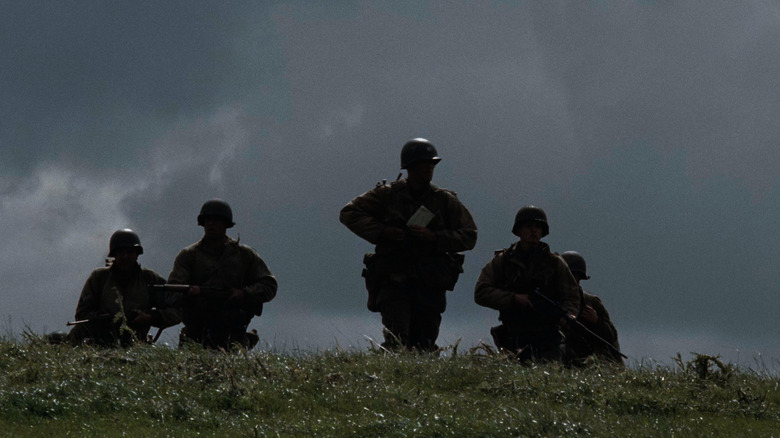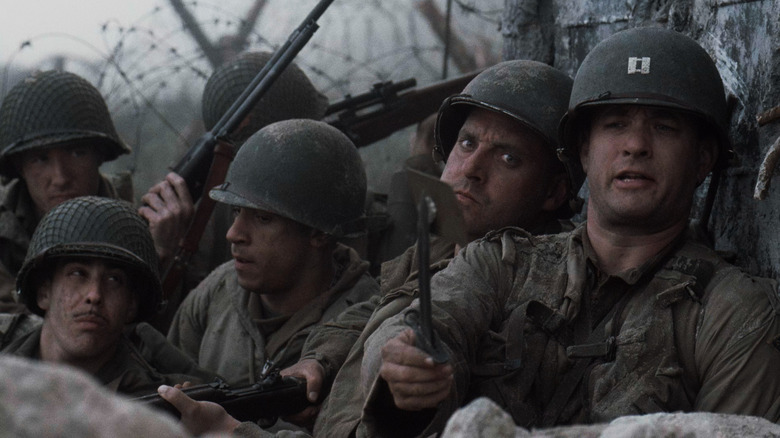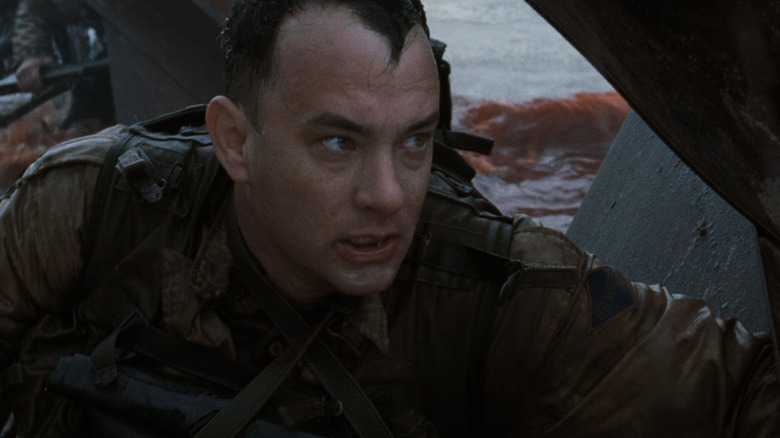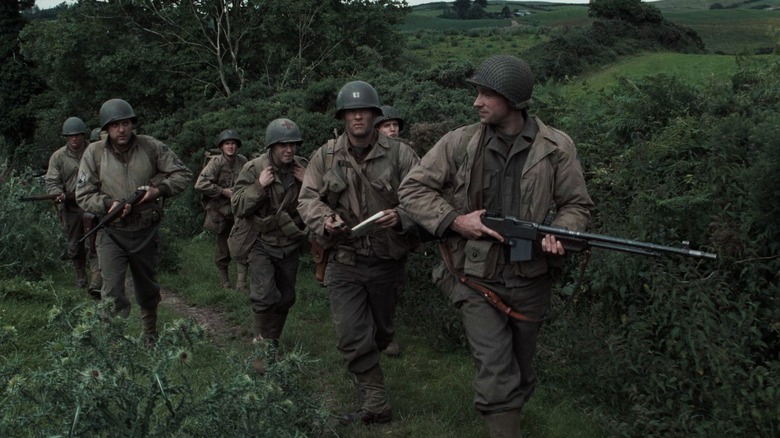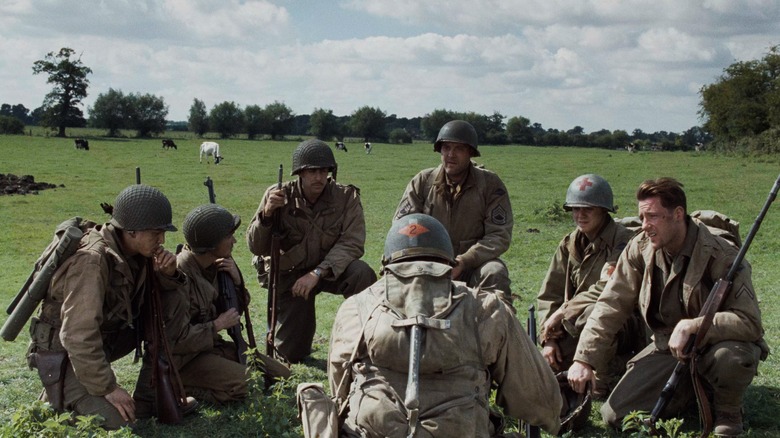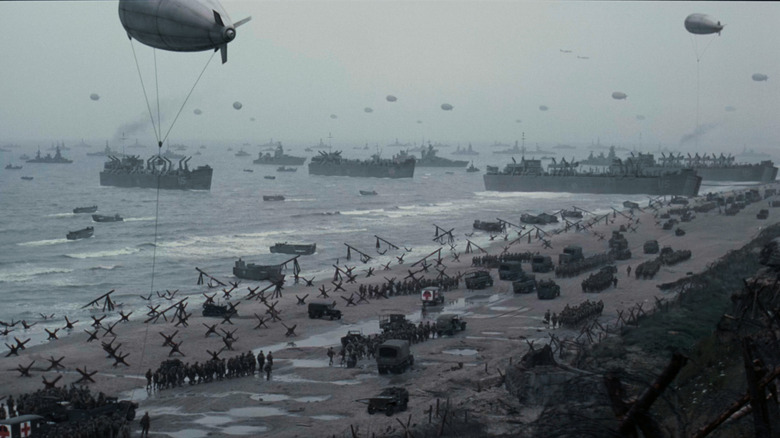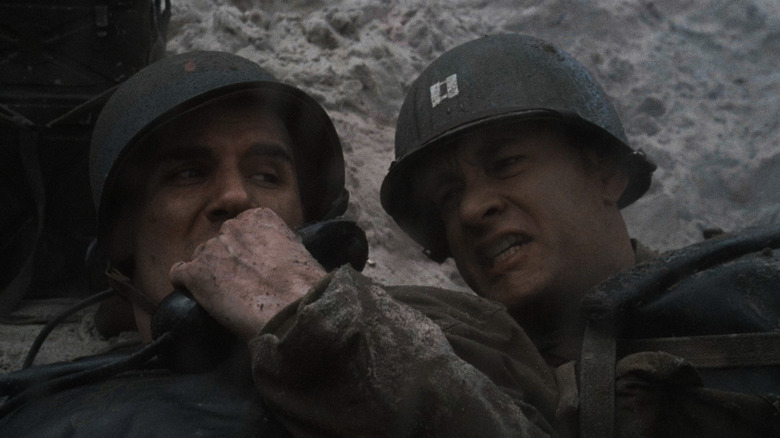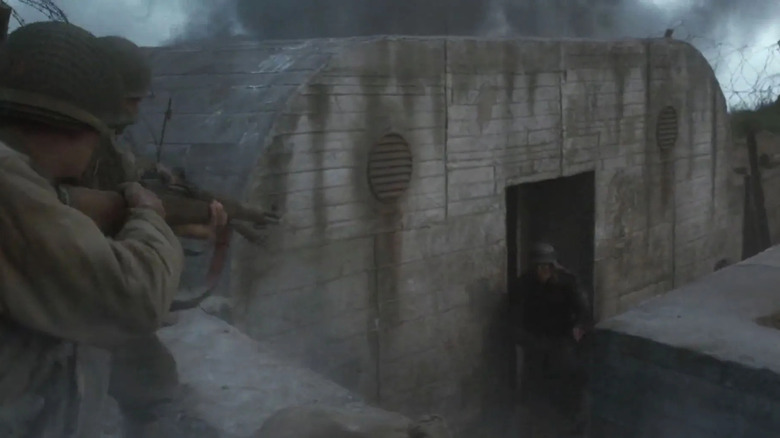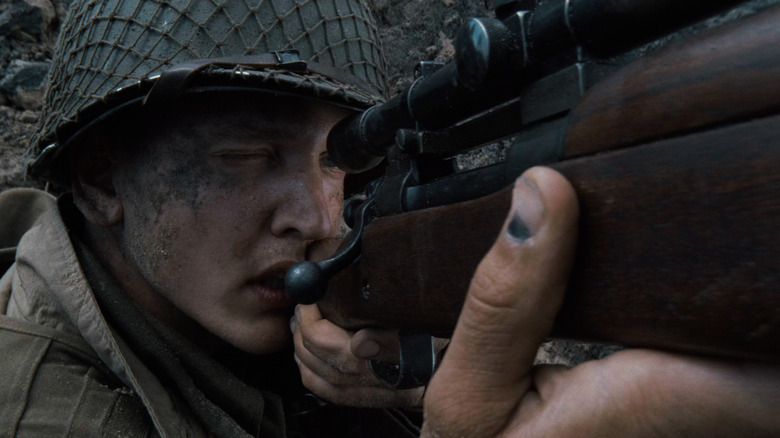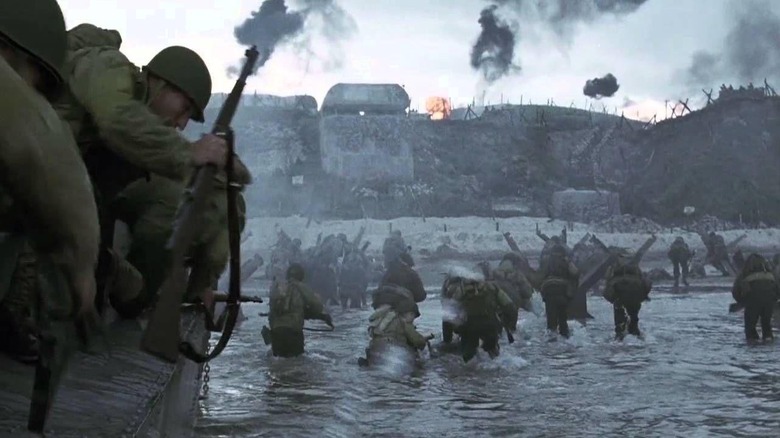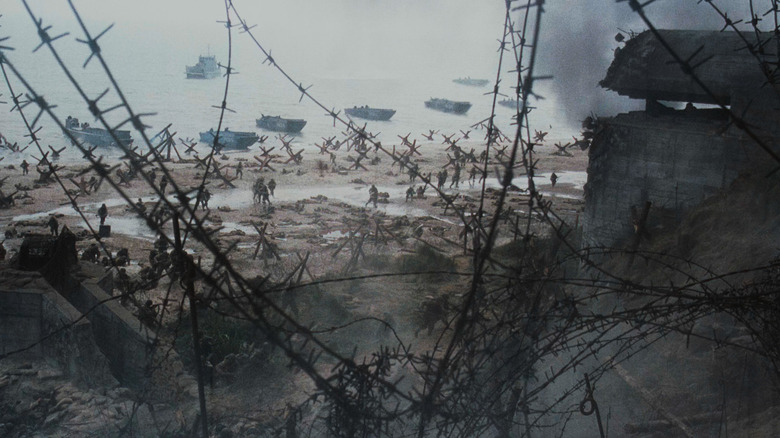10 Terrible Saving Private Ryan Moments, According To A Historian
"Saving Private Ryan" is lauded as a compelling and largely accurate war movie that starts with a striking depiction of the D-Day invasion, focusing on the U.S. forces that took on the supremely difficult terrain of Omaha Beach in Normandy. With a high-powered cast that included Tom Hanks, Matt Damon, and an early-career Vin Diesel, it tells the story of a group of U.S. soldiers led by Captain John Miller (Hanks) in a quest to retrieve a lost soldier, the titular Private James Ryan (Damon). Ryan's three brothers have already died, and the War Department has determined that someone has to find the remaining Ryan and bring him back home, lest his family lose all their sons in World War II.
Yet, for all that it's well-regarded amongst historians and film buffs alike, "Saving Private Ryan" isn't perfect. While it may give you a dramatic and deeply affecting sense of what it was like to storm the beach on D-Day, it isn't strictly something that should be quoted as an academic source. To get a better sense of where this war movie gets tripped up, we spoke to Mat McLachlan, a war historian and battlefield guide who's given tours of the area through Mat McLachlan Battlefield Tours and also speaks on battlefield history via podcasting and his YouTube channel, Mat McLachlan History. Though he freely called "Saving Private Ryan" a great movie, McLachlan also outlined the ways in which this film could have done better as far as historical accuracy is concerned.
Could the film be overly focused on American soldiers?
If you were to go only by what's on screen while you're watching "Saving Private Ryan," you might get the idea that the D-Day invasion was a largely American affair. But, "While this is an American film telling an American story, D-Day was actually a huge collaborative effort, with 13 Allied nations involved," McLachlan told Grunge. Of the estimated 160,000 troops that landed in Normandy, about 73,000 were American. A further 83,000 came from Britain and Canada combined, while there were also Allied soldiers on the beaches who hailed from France, Australia, Greece, the Netherlands, Norway, and quite a few other places. The U.S. stormed Omaha and Utah Beaches, while British and other forces took Gold and Sword Beaches, and Canadian soldiers captured Juno Beach.
McLachlan also noted a point where the film gets history wrong to the detriment of the British. "[At] one stage two U.S. officers are depicted denigrating the efforts of British troops and suggesting they were 'taking their time' capturing Caen, one of the key towns in the landing sector," he explained. "In reality, the British were fighting a grueling six-week campaign to capture the town." Capturing Caen was critical to Allied success, and British troops really did fight against the Germans there in a punishing campaign that saw hundreds of deaths against a fairly well-organized and well-equipped German defense.
The ages of the actors aren't right at all
With full respect to Tom Hanks and other members of the "Saving Private Ryan" cast, most of the people you see on screen are simply too old to be there. "The average age of U.S. soldiers that landed on D-Day was 22, and the 2nd Rangers, being an elite unit, would likely have had a larger share of 19 and 20-year-olds," said McLachlan. At the time, Hanks was in his 40s, Tom Sizemore in his 30s, and Ted Danson — yes, Ted Danson briefly appears as Captain Fred Hamill, commanding troops in a besieged French town — was about 50 years old. Giovanni Ribisi, at the time in his early 20s, was the only main cast member who reflected the average age of the real D-Day soldier.
The U.S. first instituted the Selective Training and Service Act of 1940 (also known as the Burke-Wadsworth Act) in September of that year, which required that all men from ages 21 to 35 register for the draft. It was ostensibly the first peacetime draft in the nation's history, though practically speaking, the war in Europe and Asia was a clear influence on the U.S. government's decision to enact the draft. By November 1942, with the U.S. now very definitely a participant in WWII, the draft age was lowered to 18 and its upper limit to 37.
The whole mission doesn't make sense
Noble as it may be, the plot of "Saving Private Ryan" doesn't really make sense. Yes, there was a quasi-official "sole-surviving son" policy that meant siblings or other family members weren't meant to serve in the same unit. It also held that if someone died in action, any siblings in the service could return home. "Saving Private Ryan" is ostensibly based on the story of Frederick "Fritz" Niland, who enlisted in the U.S. military with brothers Preston, Robert, and Edward. All but Fritz apparently died by June 1944 (actually, Edward was a POW who later returned home). Fritz was called out of active duty for the rest of the war. Congress formally passed it into law in 1948.
But the Niland story doesn't line up with what's depicted on screen. The military knew where Fritz was all along, and it's unlikely that any commander would send a whole unit off into dangerous enemy territory to recover a single soldier. Or, in McLachlan's words: "in the middle of the greatest invasion in history of warfare, where Allied success was far from certain in the opening days, no general is going to send a squad of men strolling deep into enemy territory to look for an individual soldier, no matter how many brothers he had lost." Simply put, such a decision would have gone against the good sense of any officer. Private Ryan would just have to look out for himself a while longer.
Why would one unit go after a soldier from a totally different unit?
Besides the improbability of a unit pushing deep into German territory to recover one man, one wonders why soldiers would go after someone from an entirely different part of the military. "Tom Hanks's unit belonged to the 2nd Rangers and landed at Omaha Beach. But Private Ryan was with the 101st Airborne, which landed behind Utah Beach, the other American landing beach," Mat McLachlan said. Sure, a map may make it seem like a simple hike from one beach to another, but the reality is that getting off the beaches was no easy task. Clearing exits and connecting the disparate landing sites was laborious. By midnight on what was then June 7, Canadian forces at Juno Beach still weren't able to connect with British forces at Sword Beach next door, though they had managed to set up exits from Juno.
According to McLachlan, "In order for Tom Hanks and his men to even get to the area where Private Ryan was likely to be, they had to walk for more than 25 miles through territory that was still held by the Germans, an impossible task in the days after D-Day." If, somehow, an officer had decided to send a group after Private Ryan, it would have likely been a detachment from the 101st Airborne, said McLachlan. At the very least, it would have been a group that had already landed at Utah Beach, not Omaha.
The anti-landing craft obstacles are notoriously misplaced
Spielberg and company are probably sick of hearing this, but any roundup of "Saving Private Ryan" flubs has to include the landing obstacles seen on screen. Simply put: they're backwards. McLachlan gives more context, saying: "The Germans had improvised obstacles that were designed to tip over landing craft at high tide, which consisted of a large log at an angle supported by a frame, often fitted with a landmine. The theory was that landing craft would be launched up the ramp and either capsize or be destroyed by the mine."
Simple as they may have been in theory, these ramps could have been deadly to Allied landing craft and the soldiers within. However, Field Marshal Erwin Rommel, in command of the German forces in Normandy, mistakenly assumed that Allied troops would have to land at high tide and installed defenses with that in mind. The Allies actually landed at low tide, making these obstacles all but useless. In fact, some of the obstacles, such as the spiky metal assemblages known as "hedgehogs," gave soldiers much-needed coverage from enemy fire as they planned their next moves. That's not to say that taking Omaha Beach was easy. Compared to other landing sites, the terrain here was especially difficult, with a long, exposed approach to the sea cliffs where German soldiers were positioned. This path included navigating a nasty tangle of razor wire that typically had to be breached by explosives for soldiers to move forward.
Saving Private Ryan makes the odd claim that there were no tanks on the beach
In the dramatic, lengthy scene where Allied troops storm Omaha Beach, Tom Hanks' Captain Miller claims that no armor has landed on the beach, then goes on to specify that soldiers there have no access to "DD tanks." But, as McLachlan points out, that is patently false. "The film perpetuates the myth that no Allied armour (tanks) successfully landed at Omaha Beach. This wasn't true, and the tanks were essential in getting the troops off the beach," he said.
Why did the film make such an easily dismissed claim? It could be that the amphibious DD (duplex or dual drive) tanks involved in the landing really did succumb to many hits, with 27 out of 32 DD tanks sinking (though on the other end of Omaha Beach to where Miller's unit landed). However, it's clear that some of those tanks did make it, as did others meant to help clear the beach and move deeper into France. These included a modified Churchill tank that laid down a kind of carpet allowing heavier vehicles to move across soft sand, tanks that carried equipment to bridge up to 30-foot expanses, and, eventually, personnel carriers to more efficiently move troops inland. However, it wasn't all good news, as part of the messed-up truth about D-Day is that some so-called amphibious tanks actually sank and led to the drowning deaths of the crews inside.
German soldiers weren't stupid
If you watch enough WWII films, you may notice what's dubbed the "dumb German" stereotype. The general picture, at least as it's related in quite a few American films, has German soldiers making nonsensical decisions that allow heroic Allied forces to triumph and basically look good in comparison. That stereotype of stupid, brutish German soldiers goes back to at least the First World War, the same time Germany turned around and used propaganda to depict British colonial and Russian soldiers as sub-human.
Propaganda aside, the realities of war mean that intelligent, capable people were making decisions on both sides. That's not necessarily so in the world of "Saving Private Ryan," as McLachlan points out. "In one early scene, a group of Germans rush out of a bunker after grenades have just been thrown in, straight into the waiting gunsights of Americans," he notes. "Later the German infantry advance behind their tanks, giving the Americans the chance to blow up the tanks before encountering the infantry. The German sniper (whose most important job was to target officers) chooses to shoot a lowly private instead of the clearly-marked captain standing next to him." Captain Miller should have been in far more danger ... if he and his unit had even made it that far. It's not as if the Germans were perfectly trained and well-supplied — obviously not, as the Allies broke through their defenses — but neither were they running straight into gunfire in mindless panic.
You may spot weapons oddities
You can't get away from weapons in a war film. In "Saving Private Ryan," soldiers on both sides are shown using all manner of weapons, from grenades to sidearms, to tank artillery, to machine guns. Snipers figure prominently in the plot, including a German sniper who pins down Captain Miller's unit in the fictional French town of Neuville. He's defeated by the Americans' own sniper, Private Jackson. Yet, for all of the highly-skilled sniping going on, McLachlan notes that, in the film, "weapons and their use are often inaccurate."
Even Private Jackson isn't exempt. As other historians have noted, in some scenes he sports a bruised thumbnail. That's not the result of an accident involving actor Barry Pepper, but a period-accurate detail known as M1 thumb. At the time, M1 Garand rifles were common, but incorrect loading meant the rifle's bolt could strike a marksman's thumb, causing characteristic bruising. So, why is such a detail wrong here? Private Jackson appears to be firing a Springfield rifle, not an M1. Plus, the film sets him up to be an incredible sniper, so a rookie goof-up like M1 thumb is out of place for his character.
German soldiers are also seen operating their guns pretty much continuously, but historians and ballistics experts likely already know that this would cause the gun to overheat. This would lead to increasingly poor accuracy, obviously a major issue. Instead, soldiers were trained to fire machine guns in short but deadly bursts.
German defenses as seen in the film are inaccurate
Another way in which "Saving Private Ryan" misrepresents the German side of the invasion is in its depiction of Axis defenses at Normandy. Specifically, the pillboxes are downright palatial. "The German defenses depicted in the film are pure Hollywood," McLachlan said. "The Germans did have concrete emplacements protecting the beaches, but they were considerably smaller than the multi-story, apartment block-sized bunkers depicted in the film." McLachlan also noted that, in the film, the Germans are firing from these concrete structures straight at the beach. In real life, they would have been firing enfilade (lengthwise) along the landing site.
So, what were the real German concrete defenses like? Also known as pillboxes, they were common throughout battle sites and defenses in both the First and Second World Wars. In fact, visit Normandy and you can see the remains of these war-torn defenses today. Though small, they were built with reinforced concrete and sometimes featured a layer of cast iron armor. In the aftermath of WWI and as hostilities increased in Europe, German forces installed more pillboxes to defend against possible invasion. At the Normandy beaches on D-Day, pillboxes were definitely in place, but were hampered by a German army that was already stretched thin and was expected to cover a wide swathe of territory against invading Allies. Even with the natural layout of Omaha Beach giving them additional cover and obstacles, not to mention a wealth of these concrete bunkers, the resource-strapped Germans failed.
The film could give the Navy way more credit
Given that "Saving Private Ryan" follows a unit of U.S. service members as they make their way on foot through Normandy, it's perhaps not surprising that we get a pretty terrestrial view of the D-Day invasion. Yet, despite both that and the dramatic 20-minute or so opening showing the taking of Omaha Beach, McLachlan noted that there's a significant player missing from much of the film: the Navy. "The main reason U.S. troops were successful in getting off Omaha Beach was that Navy ships came in close to shore and blasted the German defenses to pieces," he said.
It's true that, as you see on screen, on-the-ground tools like the explosive Bangalore torpedoes were a key tool in getting Allied soldiers off their landing sites. But while very long tubes full of explosions could break through the concertina wire laid down between the beach and the pillboxes, they weren't the sole reason the German line failed (and it definitely failed, despite Nazi propaganda attempts to make it seem otherwise). Strikes from nearby naval vessels really were vital to helping ground troops get through. Of the vessels at D-Day, the great majority were from Britain's Royal Navy and included seven battleships among the 138 British ships striking the defenses along Normandy (a total of over 7,000 Allied vessels were involved). Ships didn't just strike Axis positions, either; they took on the obviously important task of bringing troops into position. In less than a week, they carried over 300,000 personnel to Normandy, as well as their supplies.
